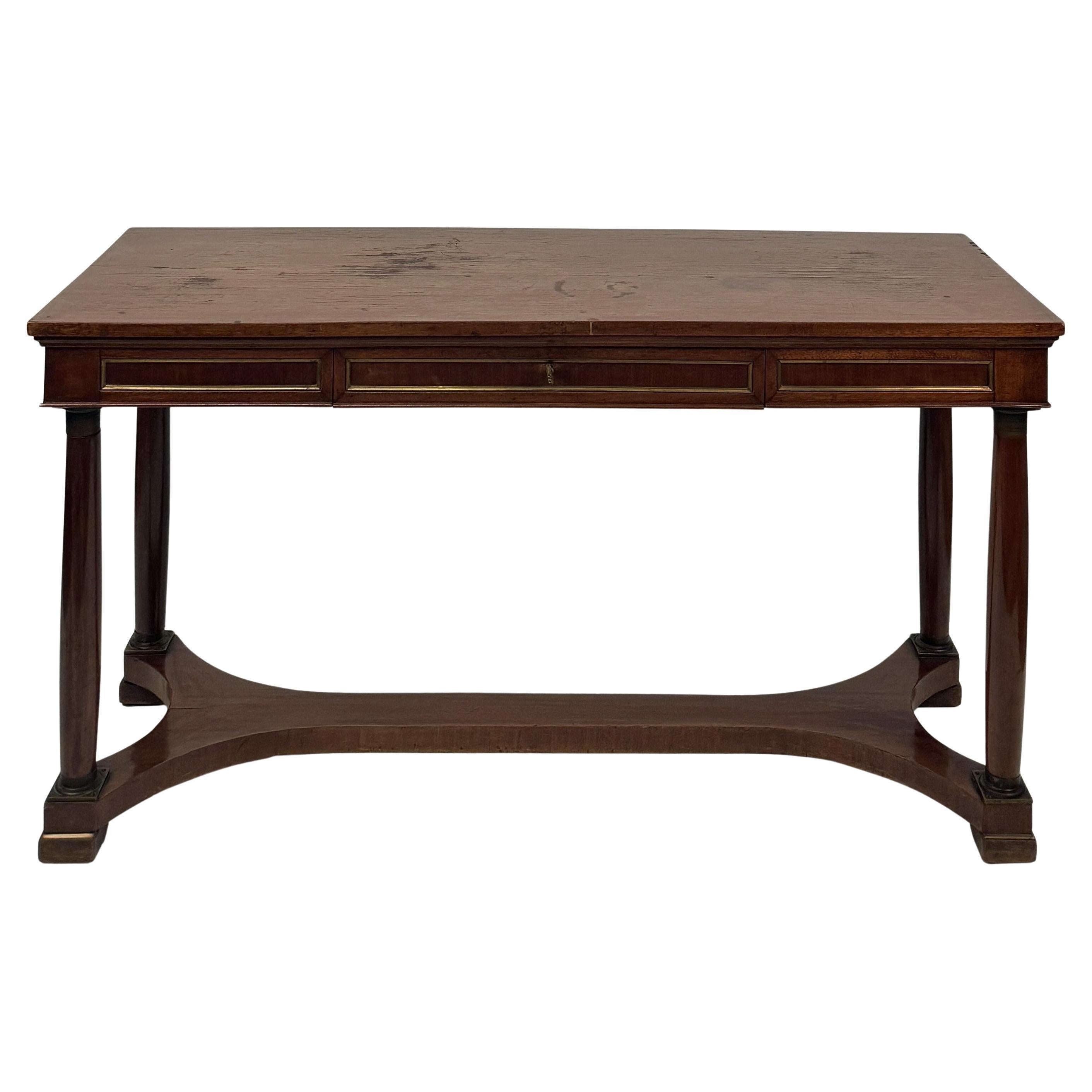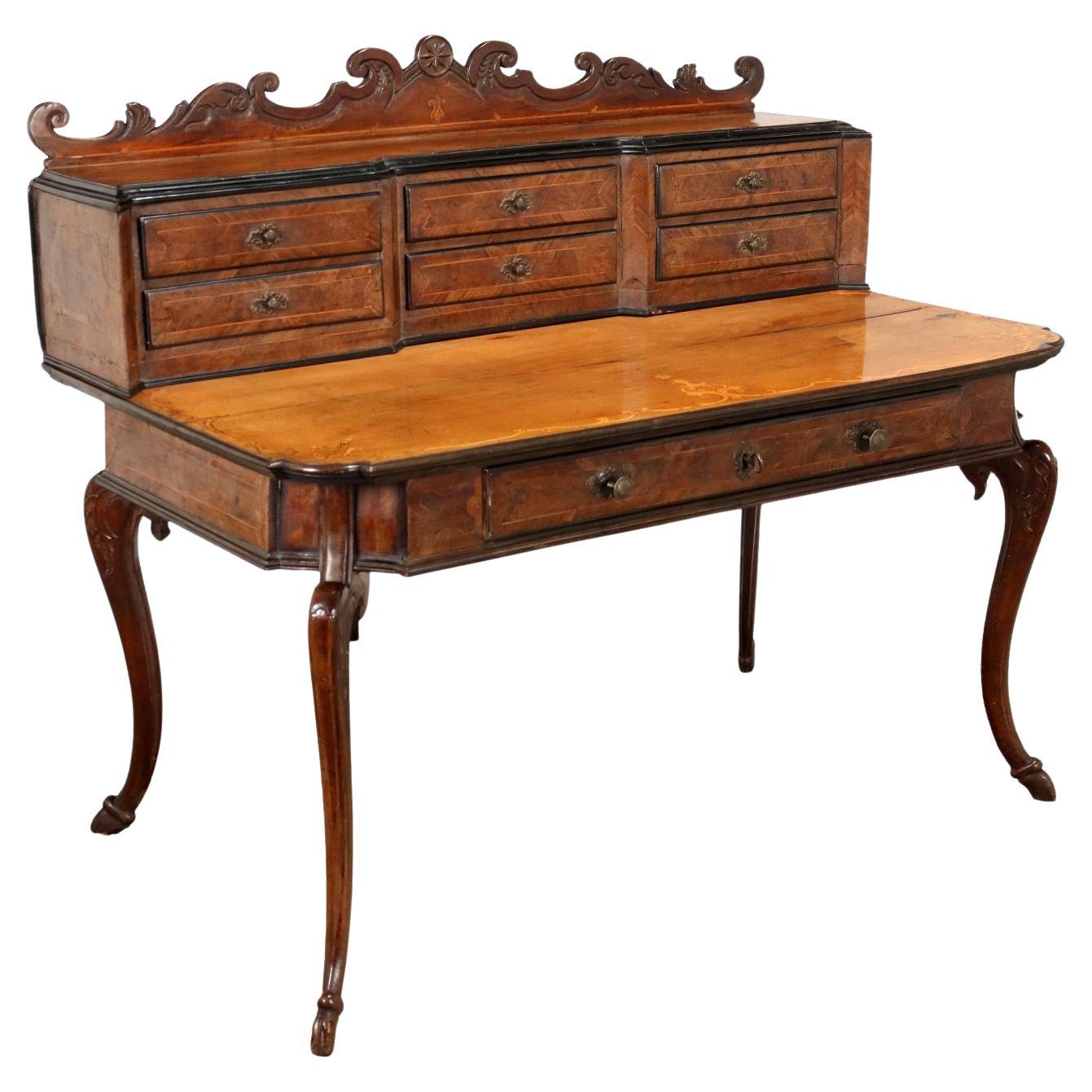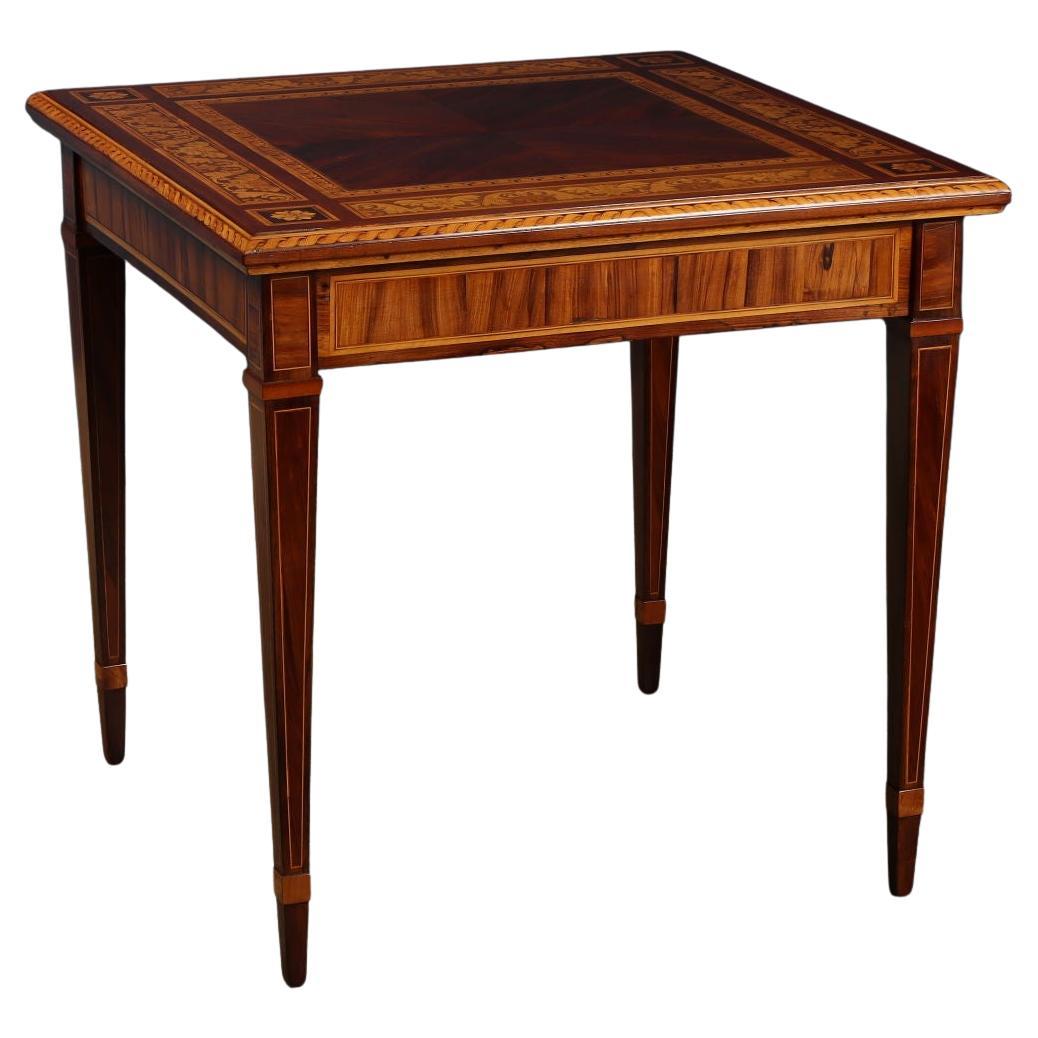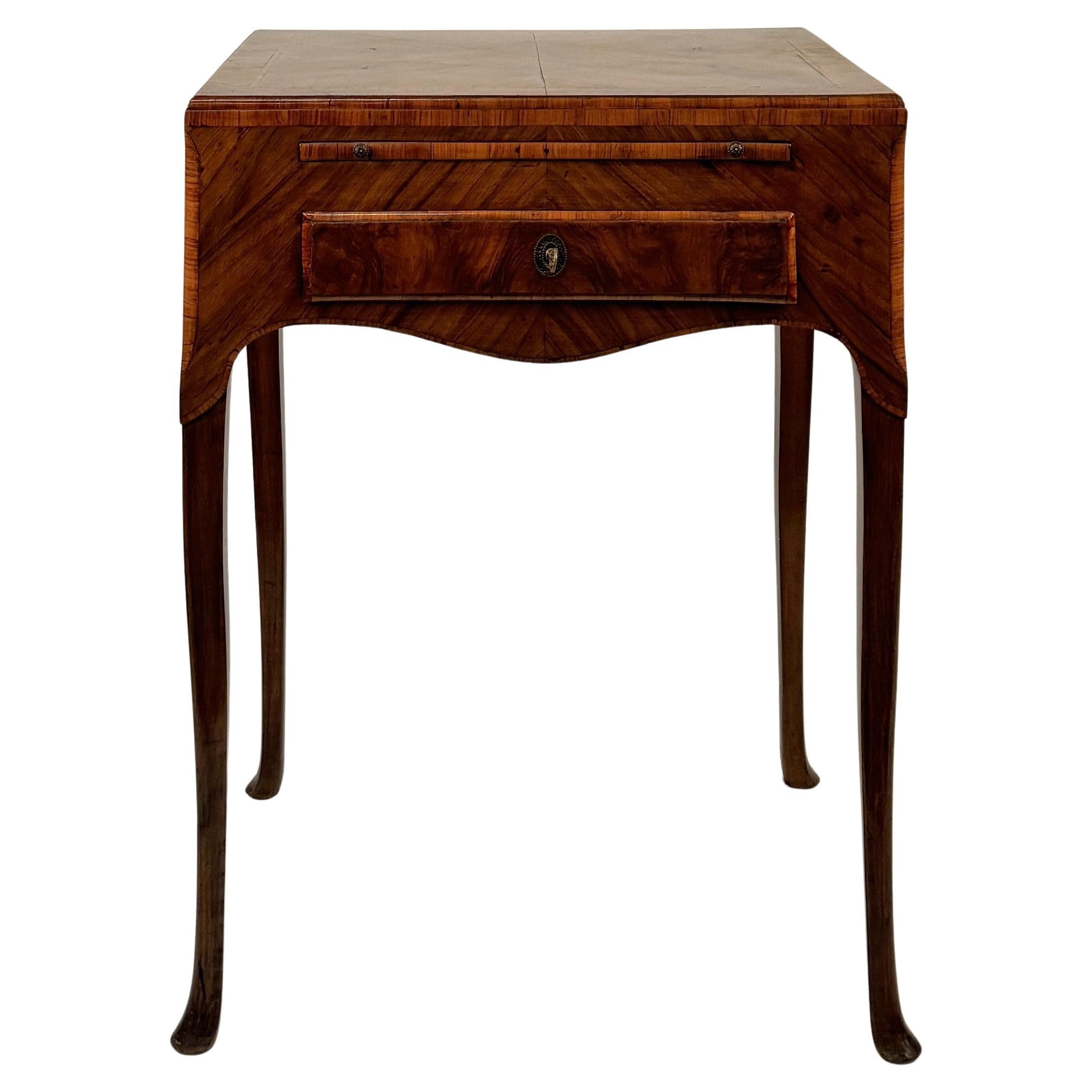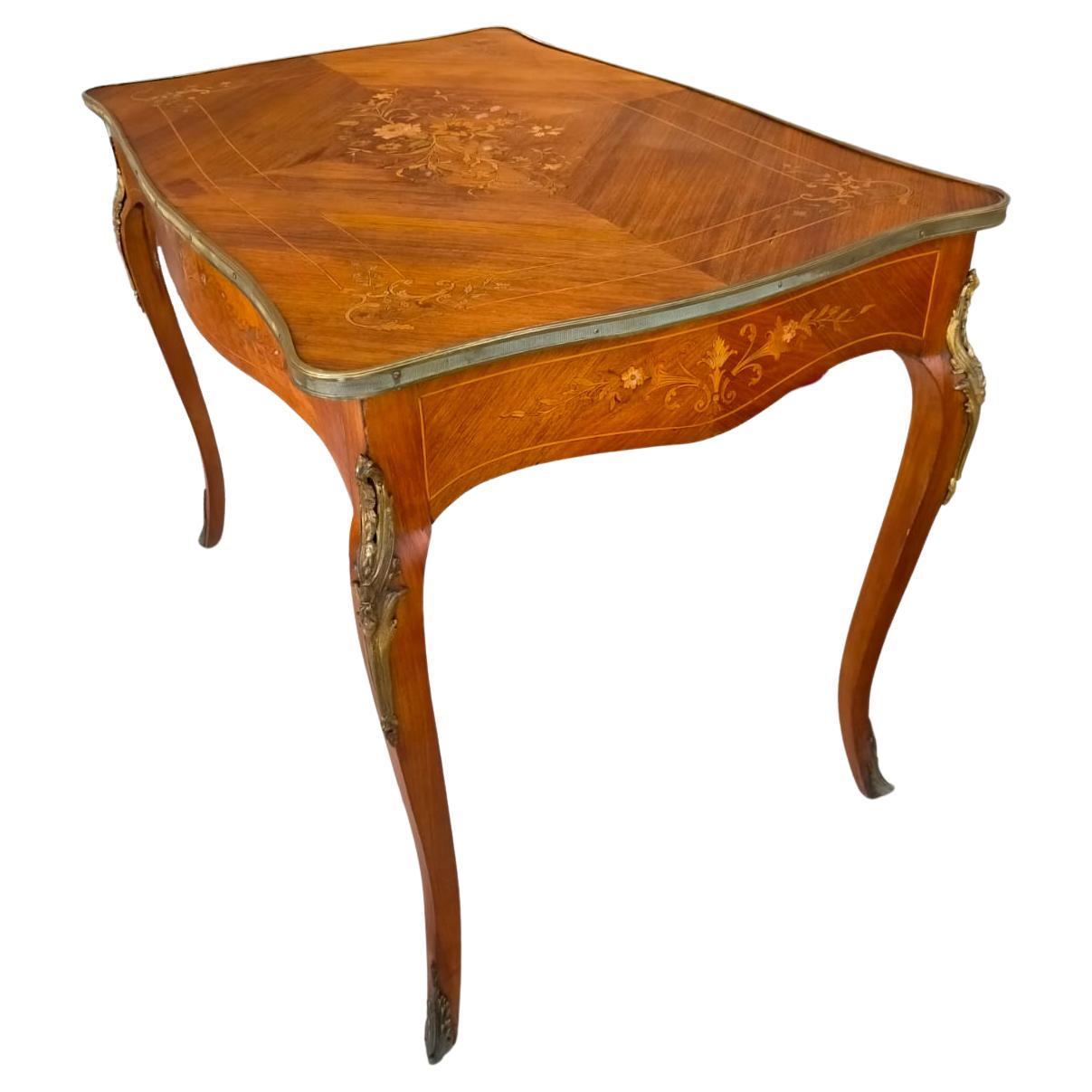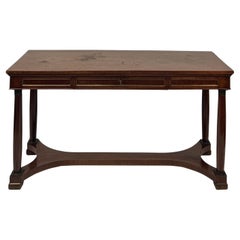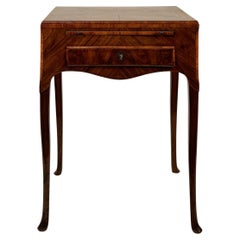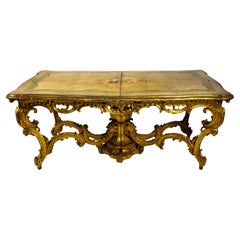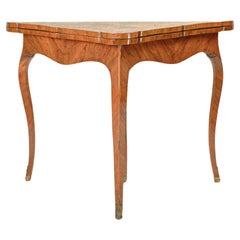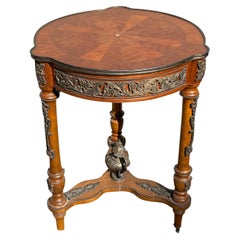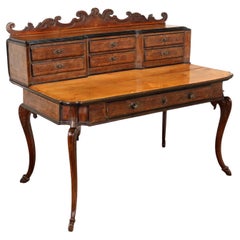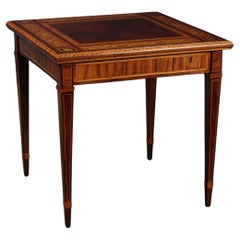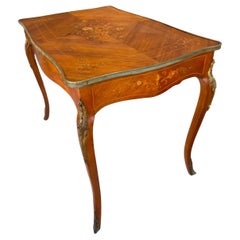Items Similar to Luigi and Angiolo Falcini, mechanical desk
Want more images or videos?
Request additional images or videos from the seller
1 of 5
Luigi and Angiolo Falcini, mechanical desk
$102,090.80
£75,691.24
€85,000
CA$140,248.77
A$153,104.45
CHF 80,611.41
MX$1,834,013.56
NOK 1,030,990.19
SEK 941,311.18
DKK 647,669.14
About the Item
Luigi and Angiolo Falcini (Campi, 1794 - Florence, 1861) and (Campi, 1801 - Florence, 1850)
Mechanical desk, 1835 - 1855, veneered in ebony and inlaid with woods of various colors, ivory and mother-of-pearl,
cm 86,5x98,5
The desk, conceived as a round-shaped center table supported by four legs joined together at the bottom by crosspieces forming a platform, has all wooden surfaces veneered with ebony and covered with floral inlays made of woods of various colors. On the plane, such naturalistic decoration follows the circular pattern and is enriched with whorls of acanthus leaves, birds, small garlands and four roundels with inserted as many figures of knights alternating with ladies in Renaissance dress. The Panciatichi coat of arms united with that of the Ximenes of Aragon placed in the center of the floor completes the entire decoration, whose neo-Baroque taste is diluted in the compositional rigor typical of Neoclassicism. Under the top are several drawers, small compartments, and a removable Moroccan-covered shelf intended as a writing desk, equipped with a small lectern and three small drawers.
As documented by the coat of arms inserted in the center of the top, the coffee table - desk was made on commission of Marquis Ferdinando Panciatichi Ximenes d'Aragona, who was born in Florence in 1813 from the marriage between Margherita Rosselmini and Leopoldo Panciatichi (1766-1818), the latter belonging to one of the richest families of the Grand Duchy of Tuscany, who in 1816 obtained by inheritance the surname, titles and vast estate of the Ximenes d'Aragona. An art lover and collector, the marquis was, beginning in the 1840s, a prominent figure within the cosmopolitan Florentine milieu taking an interest in architecture, engineering, botany and photography. A multifaceted intellectual, Ferdinando Panciatichi was also a skilled businessman and politician who helped the city's most important cultural institutions with substantial donations. His collection consisted of more than 500 paintings arranged, along with the many furnishings, objets d'art and ancient weapons, in several rooms of the Borgo Pinti palace set up as a veritable museum where a large library was also housed, later given, in 1859, to Grand Duke Leopold II and now preserved at the National Library in Florence. With the union of the two families, the Panciatichi and the Ximenes, Ferdinand inherited numerous residences including the Panciatichi palace, now owned by the Region of Tuscany, the Ximenes d'Aragona palace in Borgo Pinti (still inhabited by his descendants), where he had arranged his Gallery, and the castle of Sammezzano, which he restored by transforming it into a huge villa in oriental style. It was precisely to this vast estate that the marquis retired in the last years of his life until his death on October 18, 1897, leaving heir to his immense fortune his daughter Marianna, who, in turn, passed on her father's properties to her children Ferdinando, Alessandro and Marianna di San Giorgio, not before having sold the entire collection at auction in 1892 to divide the proceeds among her heirs (E. Santacroce, Ferdinando Panciatichi Ximenes d'Aragona and his archive between public and private, in Ferdinando Panciatichi Ximenes d'Aragona Sammezzano e il Sogno d'Oriente 1813 - 2013, edited by E. Masiello, E. Santacroce , Livorno 2014, pp. 45 - 63). The mechanical desk originally probably furnished one of the rooms of the two city palaces inhabited by Ferdinando Panciatichi and must have been used by its illustrious owner who, like the wealthiest Florentine aristocrats and collectors, had turned to the then famous inlaid furniture workshop opened in the Tuscan capital, starting around 1834, by brothers Luigi (Campi, January 7, 1794 - Florence, June 14, 1861) and Angiolo (Campi, July 1, 1801 - Florence, September 27, 1850) Falcini, both sons of a woodworker who had his workshop in Campi near Florence (S. Chiarugi, Botteghe di Mobilieri in Toscana 1780 - 1900, Florence, 1994, pp. 463 - 468). It is a few years later, and more precisely in 1836, that the first news about the activity of the two brothers dates back: at that date, in fact, Luigi alone exhibited at the Accademia di Belle Arti in Florence a small ebony table "with ornate inlay in chiaro scuro" that was awarded a medal, thus earning the interest of Grand Duke Leopold II, who then purchased it for his apartments in the Pitti Palace; followed, in 1839, by another example with a rectangular top, this time inlaid with woods of various colors, ivory and mother-of-pearl (E. Colle, The Furniture of the Pitti Palace. The second Lorraine period 1800 - 1846. The Grand Duchy of Tuscany, Florence, 2000, p. 61). Beginning, therefore, in the late 1930s, the inlays used by the Falcini family to decorate their furniture shifted from the more restrained use of ebony and ivory to a kind of floral inlay derived from the famous seventeenth-century prototypes executed by Leonardo Van der Vinne for the Medici and then displayed in the Accademia Gallery. They also devised a sophisticated technique for dyeing and shading woods capable of indulging the crowded compositions of flowers and leaves that would henceforth be the stylistic hallmark of their workshop praised even by Academy of Fine Arts President Antonio Ramirez de Montalvo. These were mostly table tops, chests of drawers, and armchairs whose surfaces, as in the case of our writing desk, were almost completely covered with inlaid panels with compositions that, while echoing the elaborate seventeenth-century creations, were subject to the compositional canons typical of Neoclassicism, whose tradition had also established itself during the first half of the nineteenth century through the teaching of the ornatists active in the Academies (E. Colle, Il mobile dell'Ottocento in Italia. Furniture and interior decoration from 1815 to 1900, Milan 2007, pp. 190 - 193, no. 43). In fact, the mechanical desk examined here features a type of decoration where floral compositions were arranged in perfect symmetry among the volutes of acanthus leaves, small roundels with figurines, birds of prey, and parrots, whose plumage is reminiscent of that of the specimens inlaid by Van der Vinne on the table tops now in the Museo degli Argenti in the Pitti Palace. Indeed, as reported by Giuseppe Del Noce (Del risorgimento e dei rapidi progressi della lignotarsia in Firenze [...], Florence 1863, p. 85), Falcini's marquetry work differed from that of other contemporary workshops because of the richness of plants and flowers meticulously taken from the vast families of exotic and local flora (as can be seen in the inlaid garland in the center of the crossbeams of the desk that belonged to the Marquis Panciatichi) adapted to the surfaces of the furnishings according to the "best models of ornamental Greek and Roman style," without, however, neglecting the study of Raphaelesque style decorations. A type of ornamentation also found on the top of a table recently hammered at the Wannenes Auction (Genoa September 22-23, 2015, lot no. 1025) that shares with our piece of furniture the inclusion, in the albeit rich ornamental composition, of the human figure and the balanced distribution of acanthus leaf whorls; while the circular arrangement of the floral decorations is similar to the description of two "tables," exhibited in Florence in 1854, "composed of three concentric circular compartments, of which the first was decorated with a rich frieze of foliage interspersed with animals, excellently effected by rightness and gradation of chiaroscuro," while the second presented a "woven garland of various flowers" and the third was "occupied entirely by various clusters of flowers naturally grouped" (V. Manteri, Report on the works of lithotarsia, xylotarsia, and intaglio [...], Florence 1854, p. 377). Compared to most of the furniture that has come out of the Falcini Workshop to date known to us, the piece of furniture examined here features a sophisticated opening mechanism that transforms it from a center table to a writing desk, which denotes Falcini's in-depth knowledge of the models made at the major Florentine cabinet-making workshops, such as the eighteenth-century workshop of Spighi or the more recent one by Giovanni Socci, the latter the author of a famous travel desk that opened, thanks to elaborate devices, to present a pull-out chair, a countertop for writing, a lectern and various secrets (E. Colle, The Furniture of the Pitti Palace [...], op. cit, p. 102, no. 27). Awarded prizes at various national and international exhibitions, Luigi and Angiolo Falcini's works were a great success with the public, and after the aforementioned purchases by the Lorraine sovereign, many were the illustrious personalities who turned to the flourishing factory to purchase their works. Among them, sources of the time mention the Duchess of Casigliano, Countess Borghesi Del Taja, Lord Holweston, Prince Anatolio Demidoff, and the eclectic Anglo-Florentine collector Frederick Stibbert. It is therefore possible that Ferdinando Panciatichi, on the wave of the fame aroused by the inlaid furniture of the Falcini brothers among collectors of the caliber of the Demidoffs or the Stibbert, also wanted to possess an exclusive piece of furniture to add to his already sizeable collections, where inlaid furniture also found a place, punctually listed in the catalog of the April 1902 auction sale (Galerie et Musée Panciatichi Ximenes d'Aragona, Entreprise de ventes a Florence Galardelli e Mazzoni, Florence 1902).
Bibliography:
Agnellini, F Simonetti, Italian Furniture of the Nineteenth Century, Milan 1991, p. 87;
Chiarugi, Botteghe di Mobilieri in Toscana 1780 - 1900, Florence, 1994, p. 197, fig. 250.
- Creator:Luigi and Angelo Falcini (Cabinetmaker)
- Dimensions:Height: 34.06 in (86.5 cm)Diameter: 38.78 in (98.5 cm)
- Materials and Techniques:
- Place of Origin:
- Period:
- Date of Manufacture:1835 - 1855
- Condition:
- Seller Location:Milano, IT
- Reference Number:1stDibs: LU9975241787102
About the Seller
No Reviews Yet
Vetted Professional Seller
Every seller passes strict standards for authenticity and reliability
1stDibs seller since 2024
- ShippingRetrieving quote...Shipping from: Milano, Italy
- Return Policy
More From This Seller
View AllMahogany center desk, 20th century
Located in Milano, IT
in the straight single-drawer belt decorated with gilt profiles like the panels decorating the sides and opposite side, column legs with metal capitals and base, joined by a molded c...
Category
20th Century Italian Desks and Writing Tables
Materials
Mahogany
Tall walnut veneer slab desk, Veneto, second half 18th 18th Century
Located in Milano, IT
Tall walnut veneer slab desk, Veneto, second half 18th century, decorated with herringbone panels, on three sides, in the belt a removable top and on the front a drawer. The tops ar...
Category
Antique Mid-18th Century Italian Desks and Writing Tables
Materials
Wood
Tavolo in legno scolpito, dorato e laccato , Lombardia XIX secolo
Located in Milano, IT
Tavolo in legno scolpito, dorato e laccato , Lombardia XIX secolo, piano decorato da un motivo centrale a fiori su fondo avorio, cintura intagliata a molteplici volute roccailes che ...
Category
Antique 19th Century Italian Dining Room Tables
Materials
Giltwood
Bois de rose panelled coffee table, Genoa 18th century
Located in Milano, IT
Bois de rose panelled folding table, Genoa 18th century, triangular closed top inlaid both outside and inside with herringbone panels centering classic cloverleaf motifs within a sle...
Category
Antique 18th Century Italian Drop-leaf and Pembroke Tables
Materials
Wood
Piccolo scrittoio ad alette in legno, XIX secolo
Located in Milano, IT
Piccolo scrittoio ad alette in mogano, XIX secolo, piano rettangolare con profilo lievemente modanato, nella cintura un cassetto suddiviso in scomparti e sui lati corti un grembiale ...
Category
Antique 19th Century Desks and Writing Tables
Materials
Wood
Scrivania "alla Mazzarino" lastronata in noce e radica, XVIII secolo
Located in Milano, IT
Scrivania "alla Mazzarino" lastronata in noce e radica, XVIII secolo, corpo mistilineo con le due parti laterali lievemente avanzate. Sul fronte un cassetto centrale e tre cassetti p...
Category
Antique 18th Century Italian Desks
Materials
Walnut
You May Also Like
Tavolino Con Intarsi in Ottone, Inizi xx Secolo, Antiquariato, Antichità
Located in Milano, MI
Tavolino con intarsi in ottone - inizi xx secolo - antiquariato - antichità - antiques - table.
Category
Vintage 1920s Italian Side Tables
Materials
Brass
Scrittoio Barocchetto Lombardo secondo quarto XVIII secolo
By Non-Standard Furniture and Lighting
Located in Milano, IT
Scrittoio poggiante su gambe mosse con piedi caprini, cassetto nella fascia sottopiano, piano e alzata con cimasa intagliata raffigurante motivi fitomorfi e stella centrale. Sul fon...
Category
Antique Late 18th Century Italian Baroque Desks and Writing Tables
Materials
Maple, Nutwood
Tavolino da gioco. Giuseppe Maggiolini, Parabiago inizi XIX sec.
By Giuseppe Maggiolini
Located in Milano, IT
Tavolino da gioco a pianta quadrata con quattro gambe tronco piramidali; il piano inserito in una cornice è dotato di una molla di sblocco che permette, sia di toglierlo per accedere...
Category
Antique Early 19th Century Italian Other Game Tables
Materials
Boxwood, Maple, Walnut
French Louis XV style inlaid writing table
Located in Cesena, FC
French Louis XV style inlaid writing table
French writing table, elegant in form, Louis XV style, with drawer and decorative bronzes in the legs and contour of the top.
Era: late 18...
Category
Early 20th Century French Louis XV Desks and Writing Tables
Materials
Bronze
Consolle in Legno Intagliato e Dorato Lombardia Ultimo Quarto XIX Secolo
By Non-Standard Furniture and Lighting
Located in Milano, IT
Consolle in legno intagliato e dorato. Fascia sotto piano tripartita, con intagli floreali e mascheroni, sorretta da quattro gambe mosse riccamente intagliate a soggetti fogliacei e ...
Category
Antique Late 19th Century Italian Other Console Tables
Materials
Wood
Tuscan Ebonized Walnut Table Late 17th Century
By Non-Standard Furniture and Lighting
Located in Milano, IT
Ebonized walnut table, truncated pyramidal legs with leaf-carved capitals, joined at the base by a wavy cross with central plume. The table top includes a beautiful scagliola top dep...
Category
Antique Late 17th Century Italian Other Tables
Materials
Scagliola, Nutwood
More Ways To Browse
E Pearl
Antique Ivory Table
Ivory Inlay Furniture
Ivory Inlay Table
Antique Ivory Desk
Van Der Vinne
Editor Desk
Empire Style Bureau
Ernest Hofmann
Executive Partners Desk
Formica Top Desk
French Dolphin Desk
Glass Trestle Desk
Henredon Heritage Desk
Heywood Wakefield Desk
Irish Library Table
Italian Olive Wood Desk
Jacques Bodart

